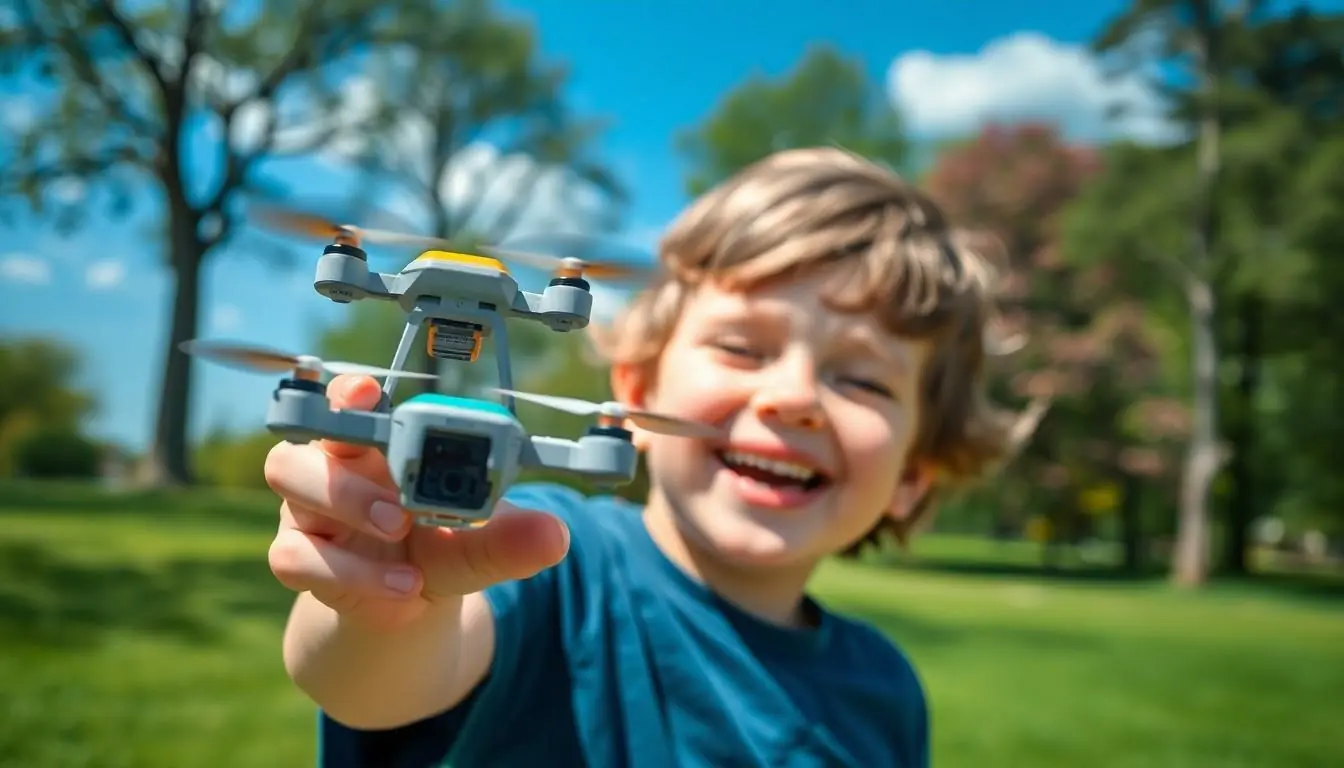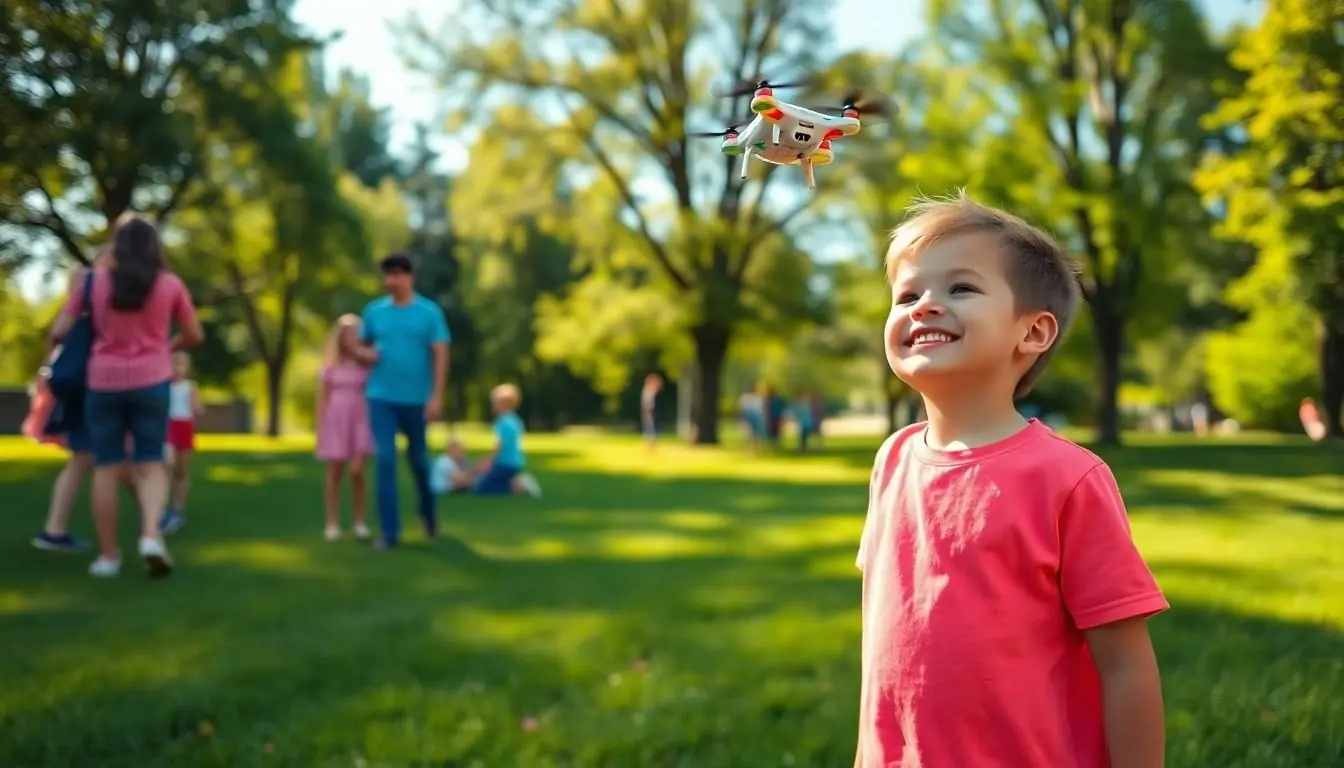Toy drones have taken the skies by storm, transforming backyard playtime into thrilling aerial adventures. These little flying wonders aren’t just for tech enthusiasts; they’re for anyone who’s ever dreamed of soaring like a bird or capturing epic selfies from above. With a simple push of a button, kids and adults alike can unleash their inner pilot and experience the joy of flight without the hefty price tag of professional drones.
Table of Contents
ToggleOverview of Toy Drones
Toy drones represent a rapidly growing segment in the recreational market. Typically designed for beginners, these drones prioritize user-friendly features. Many models offer simple controls, making them accessible for children and inexperienced pilots.
Safety is crucial in this category. Most toy drones include features like altitude hold and emergency stop functions to prevent accidents. These safety mechanisms allow users to learn flying without the fear of damaging the drone or injuring others.
Affordability plays a significant role in their popularity. Prices often range from $20 to $150, making them an attractive option for families. This accessibility encourages more people to take up drone flying as a hobby.
Variety in design enhances their appeal. Some models come equipped with cameras, allowing users to capture aerial photographs and videos. Others focus on speed and agility, ideal for racing enthusiasts.
Performance is impressive even in toy drones. Flight times typically last between 5 to 15 minutes on a single charge. Enhanced battery technologies contribute to extended play sessions, encouraging users to explore various flying techniques.
Finally, many toy drones are compatible with smartphone apps. This integration enables enhanced control and access to additional features, such as live video streaming and mapping. With these technological advancements, the appeal of toy drones continues to grow, attracting a wide range of users interested in aerial exploration.
Key Features of Toy Drones

Toy drones come with several distinct features that enhance their usability and enjoyment. Each aspect plays a significant role in driving interest among users.
Build Quality
Build quality varies among toy drones, impacting durability and performance. Many models feature lightweight materials, reducing the risk of damage during crashes. Control mechanisms rely on robust design elements, providing stability even in windy conditions. Manufacturers often implement protective frames, shielding propellers from obstacles. Additional enhancements include resistant coatings against minor impacts, ensuring longevity. Overall, strong build quality fosters user confidence and encourages adventurous flying.
Battery Life
Battery life stands as a crucial factor when evaluating toy drones. Most drones operate between 5 to 15 minutes per charge, depending on usage patterns and model specifications. Users often find that heavier aerial maneuvers consume more battery quickly. Recharge times typically range from 30 minutes to a few hours, depending on the battery capacity. Some advanced models feature removable batteries, allowing for quick swaps and extended flight time. Efficient battery performance supports uninterrupted enjoyment for users seeking an immersive flying experience.
Flight Range
Flight range defines the maximum distance a toy drone can maintain connection with its controller. Ranges usually extend from 50 to 300 meters, depending on the model and technology. Users can explore various terrains and environments within this range, making each flight more adventurous. Signal stability plays a significant role, with many drones providing visual or audio alerts when approaching limits. Enhanced connectivity features, like Wi-Fi or radio frequency, improve range performance, facilitating effortless exploration. Well-designed flight range keeps users engaged and fosters excitement during outdoor activities.
Popular Brands and Models
Numerous brands offer a variety of toy drones, each catering to different user needs. Popular options often highlight unique features that enhance flying experiences.
Brand A
DJI is a leading brand known for its innovative technology and user-friendly designs. The Tello model stands out due to its lightweight build and impressive stability during flight. It features a 5 MP camera, capturing high-quality images while in the air. Flight time reaches approximately 13 minutes per charge, allowing for extended play. Many users appreciate its compatibility with mobile apps, making it easy to control and access additional features. Costing around $99, the Tello appeals to parents and beginners alike, combining affordability with advanced functionality.
Brand B
Holy Stone focuses on providing durable and engaging drones for kids and novice pilots. The HS210 model showcases features designed for safety and ease of use. With an integrated altitude hold function, it maintains a steady flying height, adding to user confidence. Flight time lasts approximately 10 minutes, giving enough time to explore and practice. Additionally, the drone includes three speed modes, offering varying levels of challenge as users progress in their flying skills. Priced at $50, the HS210 stands out as an affordable option for families seeking quality and fun in outdoor entertainment.
Safety Considerations
Safety remains a crucial factor when using toy drones. Users must ensure proper supervision, especially for children, to prevent accidents during flight. Regular checks of the drone’s structure and functionality reduce the likelihood of malfunctions.
Many toy drones come equipped with safety features. Advanced models include altitude hold and emergency stop functions, which help maintain control during unexpected flight situations. These features significantly minimize risks of crashes or collisions.
Before flying, users should select suitable locations. Open spaces with minimal obstacles ensure a safe flying experience, allowing for comfortable maneuverability. Adhering to local regulations and restrictions further enhances safety.
Understanding battery safety is essential. Charging the drone’s battery in a controlled environment prevents overheating and potential fire hazards. Users should also wait for batteries to cool down post-use before recharging them.
Taking advantage of protective gear enhances safety measures. Users can consider purchasing propeller guards to protect both the drone and surrounding individuals. Ensuring a proper distance from bystanders during flights fosters safer interactions with the environment.
Finally, educating users on basic drone operation promotes safety awareness. Familiarizing oneself with the drone’s controls and capabilities before takeoff reduces the risk of mishaps. Engaging in practice sessions in controlled areas can boost confidence and skill levels, contributing to safer flying experiences.
Tips for Choosing the Right Toy Drone
Selecting a toy drone requires consideration of several factors. First, evaluate the age and experience level of the user. Many models cater to children and novices, emphasizing ease of use and safety features.
Consider the drone’s flight time, which typically ranges from 5 to 15 minutes. Longer flight times allow more extensive play before battery replacement or charging is necessary.
Look for durable materials in the construction. Lightweight designs often include protective frames, enhancing stability and reducing damage during falls.
Examine the features offered by various models. Drones equipped with cameras provide opportunities for aerial photography, while racing drones prioritize speed and agility. Matching these features with the user’s interests can enhance enjoyment.
Ensure that any chosen drone has reliable connectivity. A flight range between 50 to 300 meters allows users to explore different terrains effectively while maintaining control.
Prioritize safety by checking for built-in features like altitude hold and emergency stop functions. These elements contribute to a safer flying experience, particularly for inexperienced users.
Finally, research popular brands and models. Reputable manufacturers like DJI and Holy Stone provide options known for quality and performance. The DJI Tello model, priced around $99, offers a lightweight build, a stable flight experience, and a camera. Meanwhile, the Holy Stone HS210 model, available for about $50, focuses on durability and caters to beginners with its user-friendly functionality.
Choosing the right toy drone involves assessing user needs and preferences while emphasizing safety and quality.
Toy drones have transformed outdoor play by making aerial experiences accessible to everyone. Their affordability and user-friendly features encourage families to explore this exciting hobby together. With safety as a priority and a variety of models available, these drones cater to diverse interests ranging from photography to racing.
As the market continues to grow, choosing the right toy drone becomes easier with the array of options that suit different skill levels and preferences. By prioritizing safety and understanding personal needs, users can fully enjoy the thrill of flying. The future of toy drones looks bright as more enthusiasts take to the skies, fostering a community that values fun and innovation in aerial exploration.



